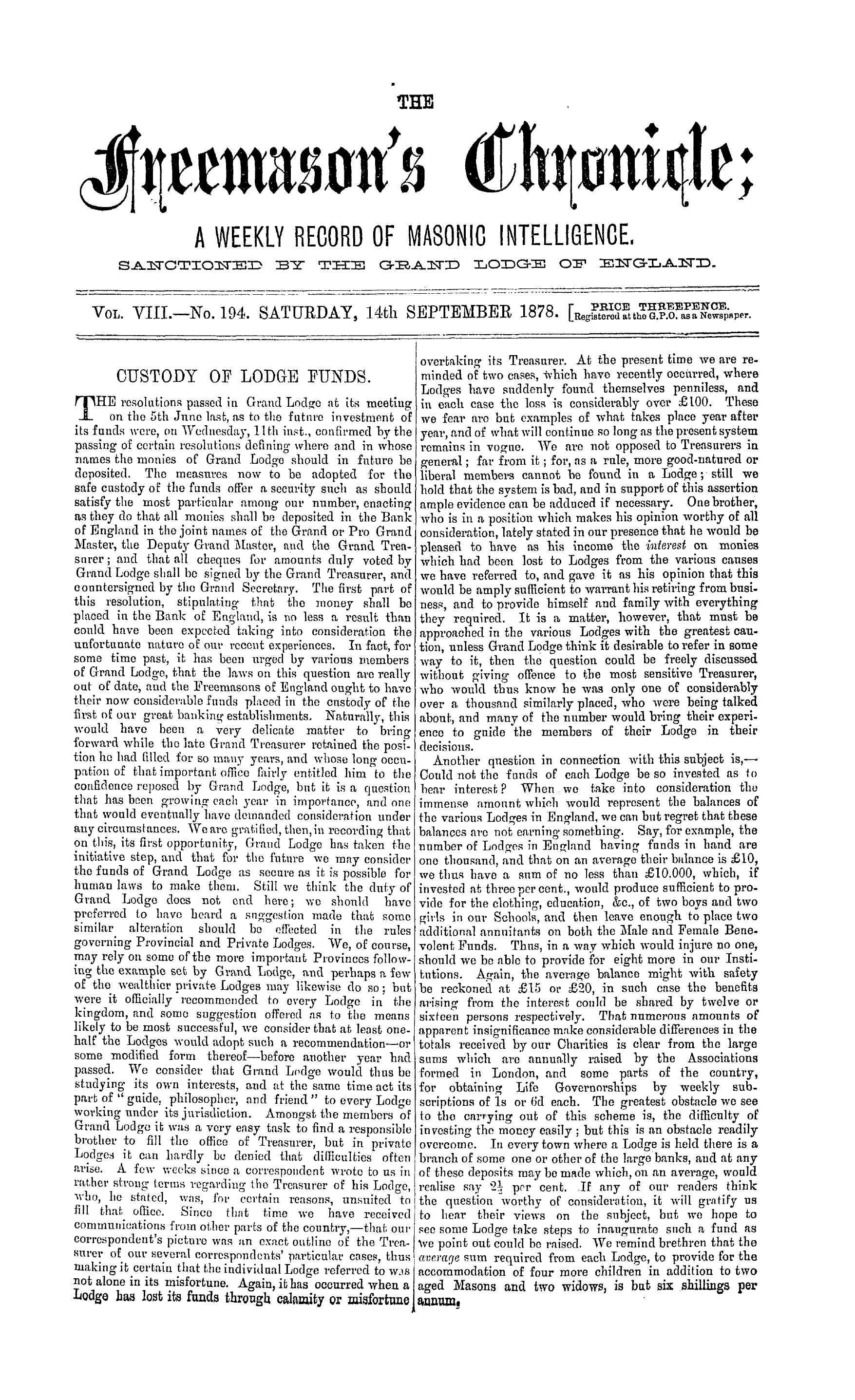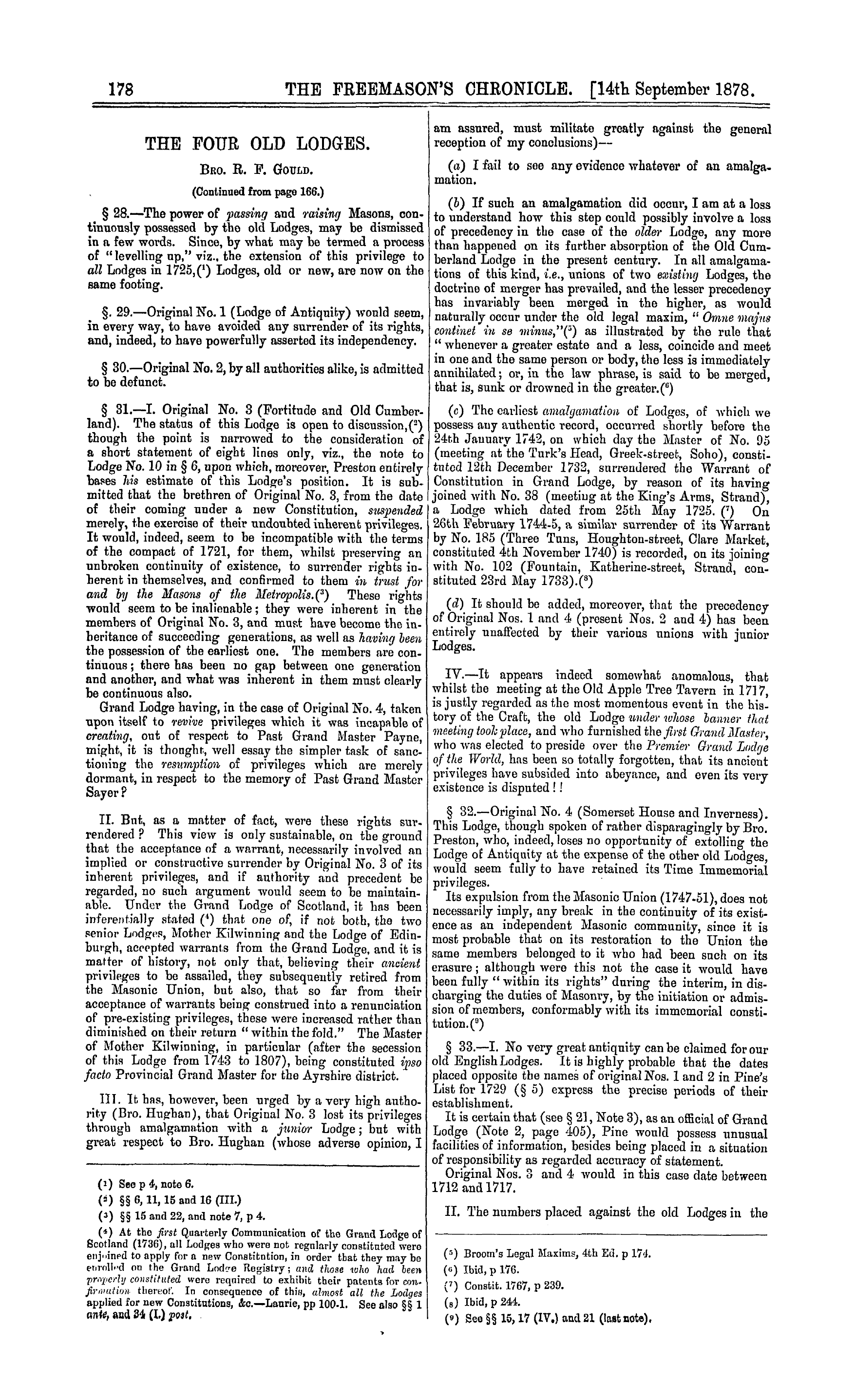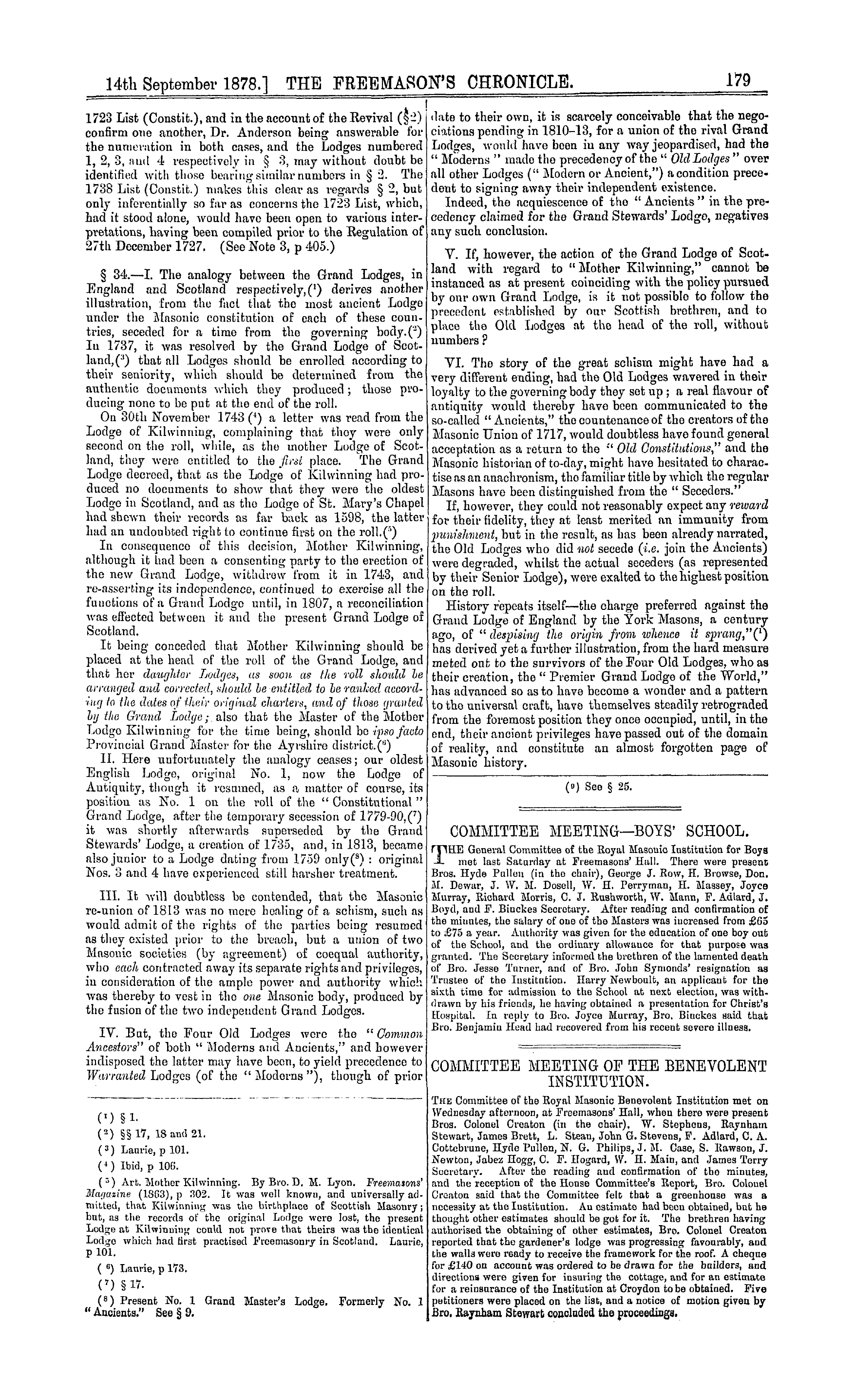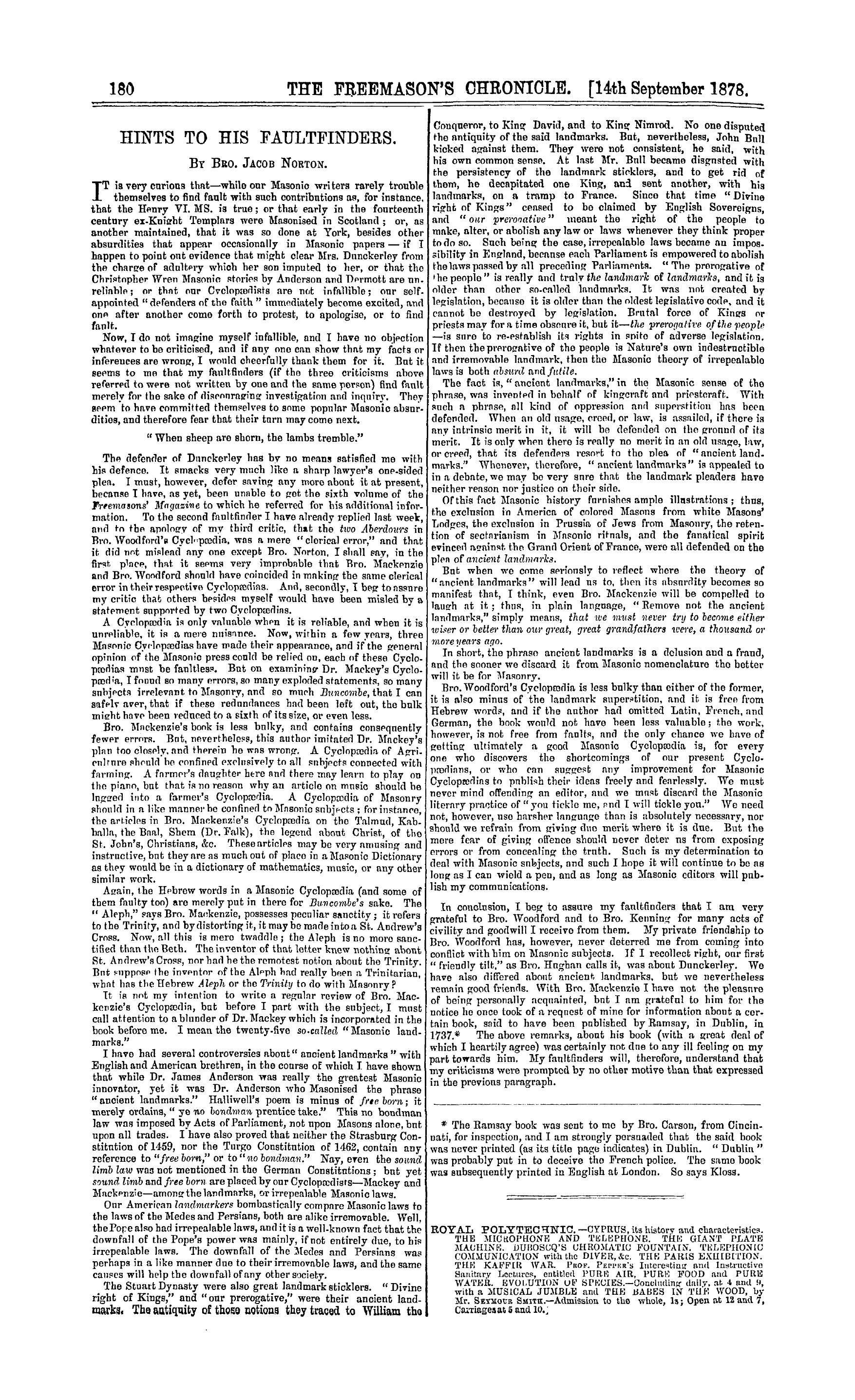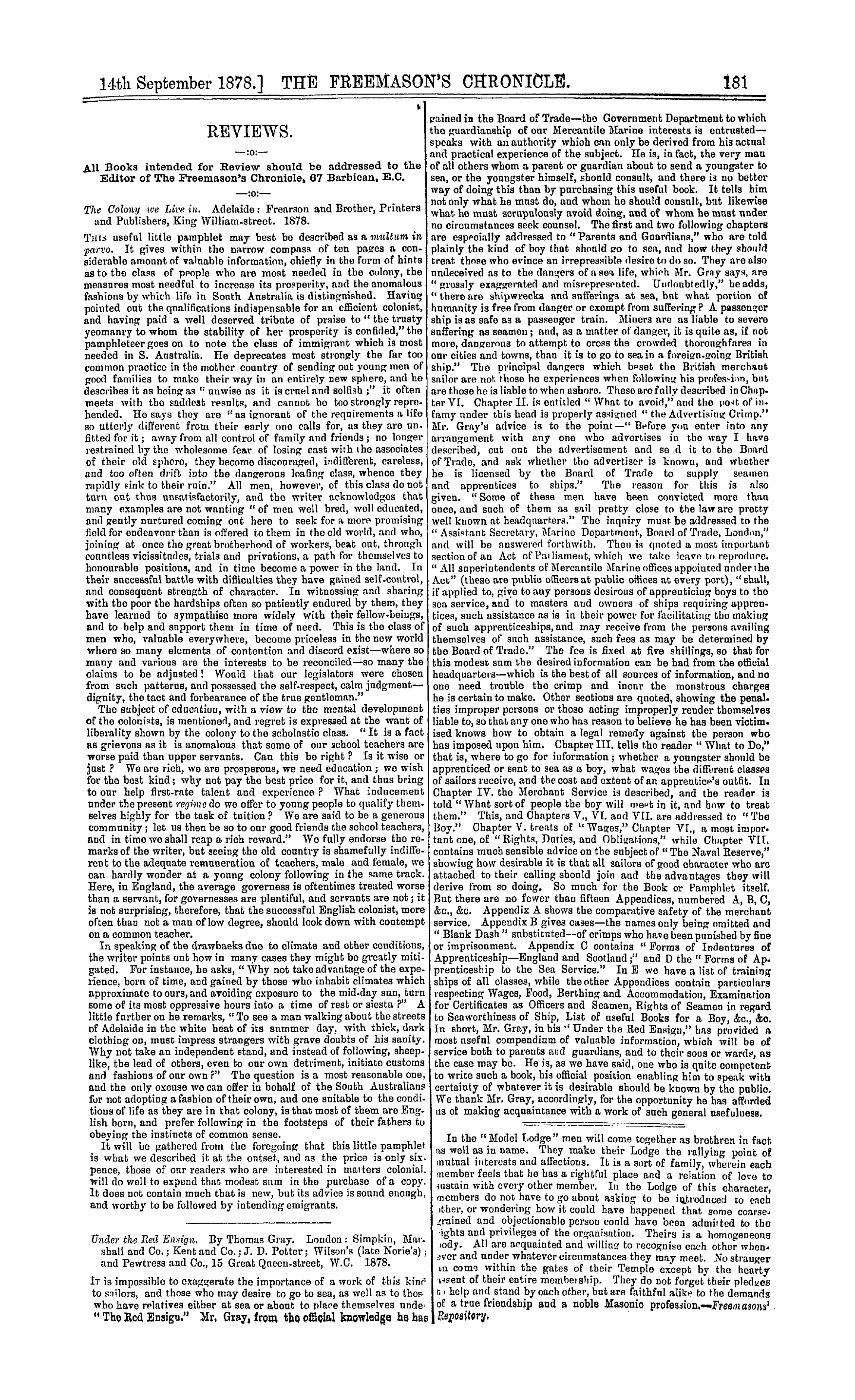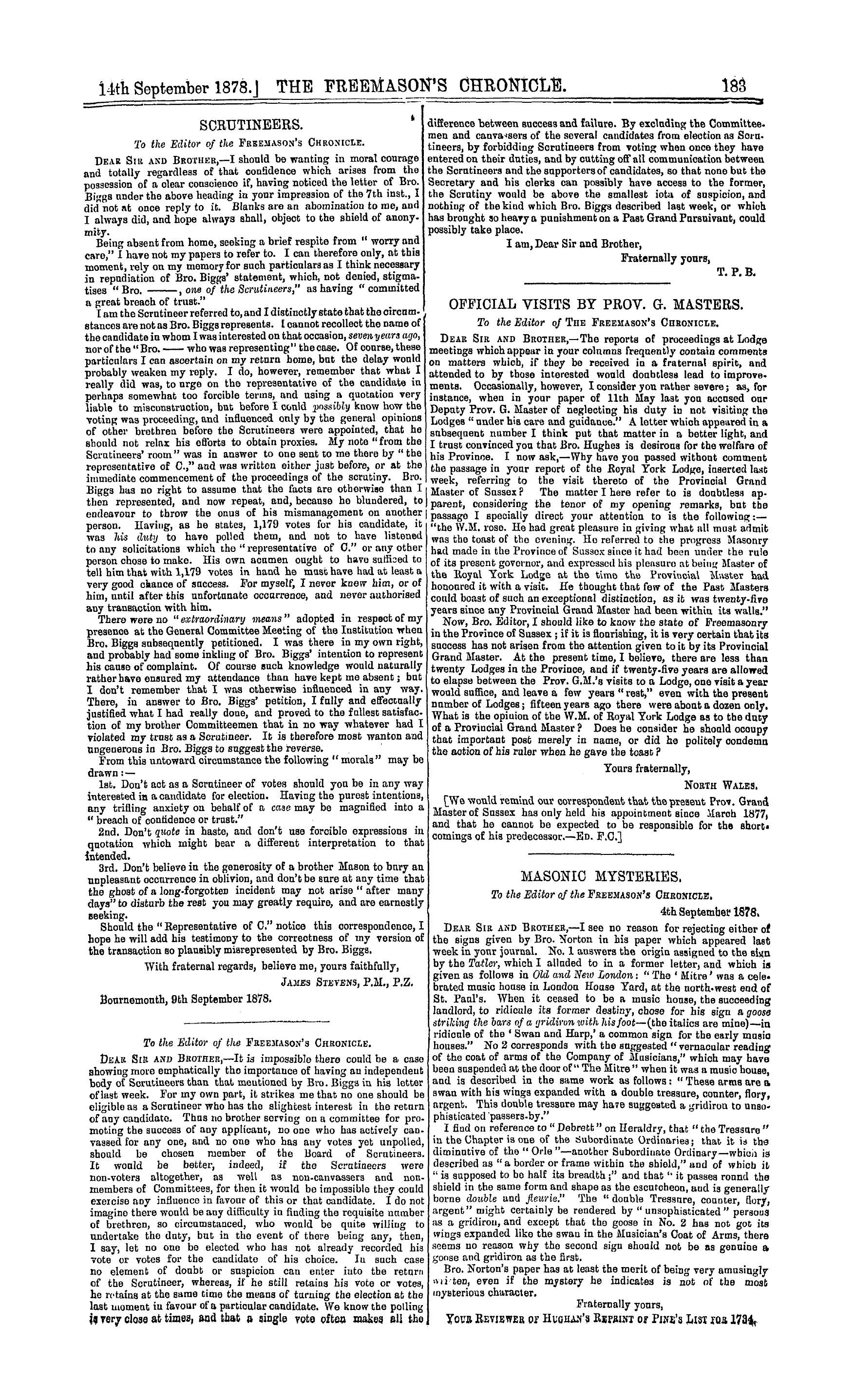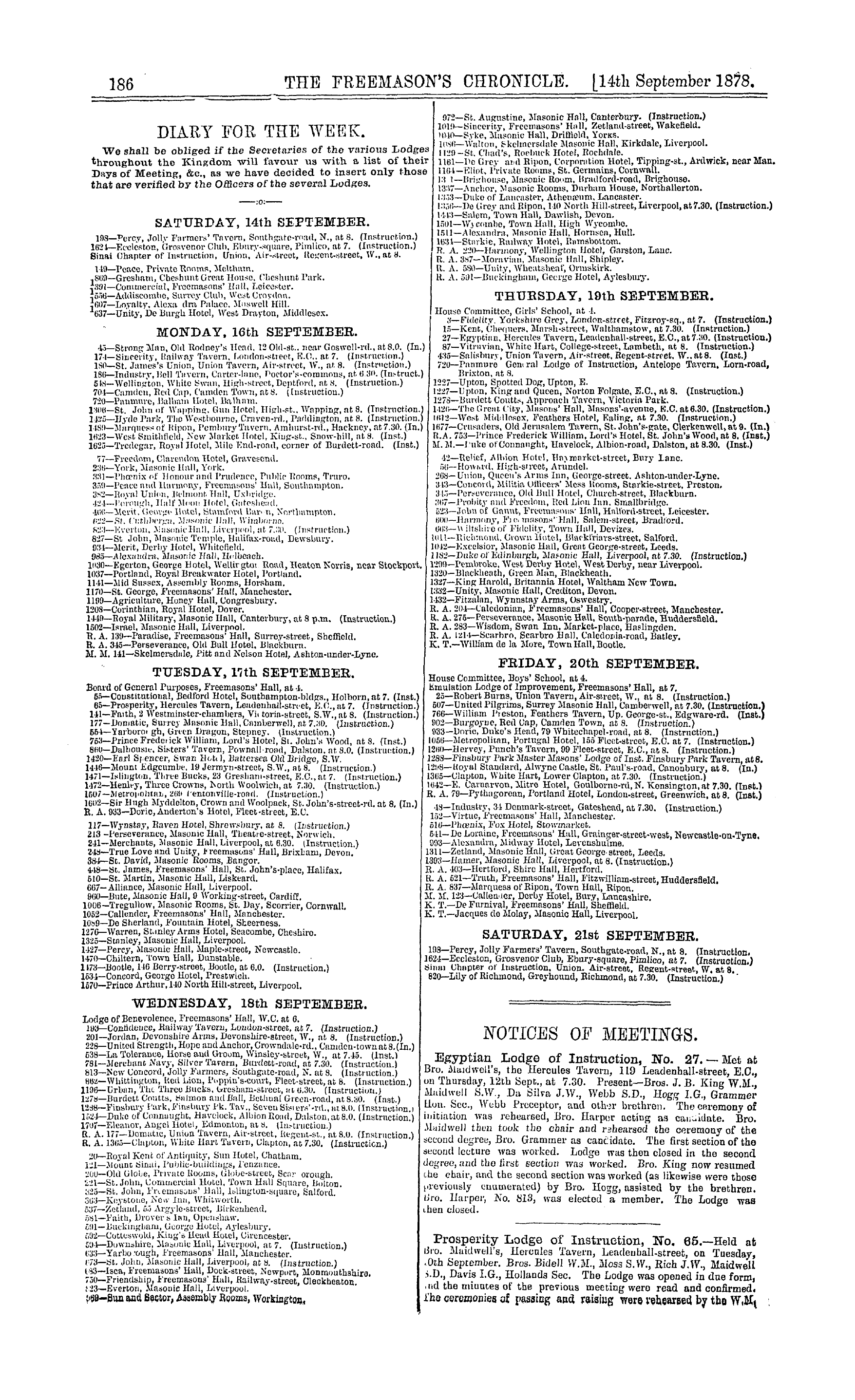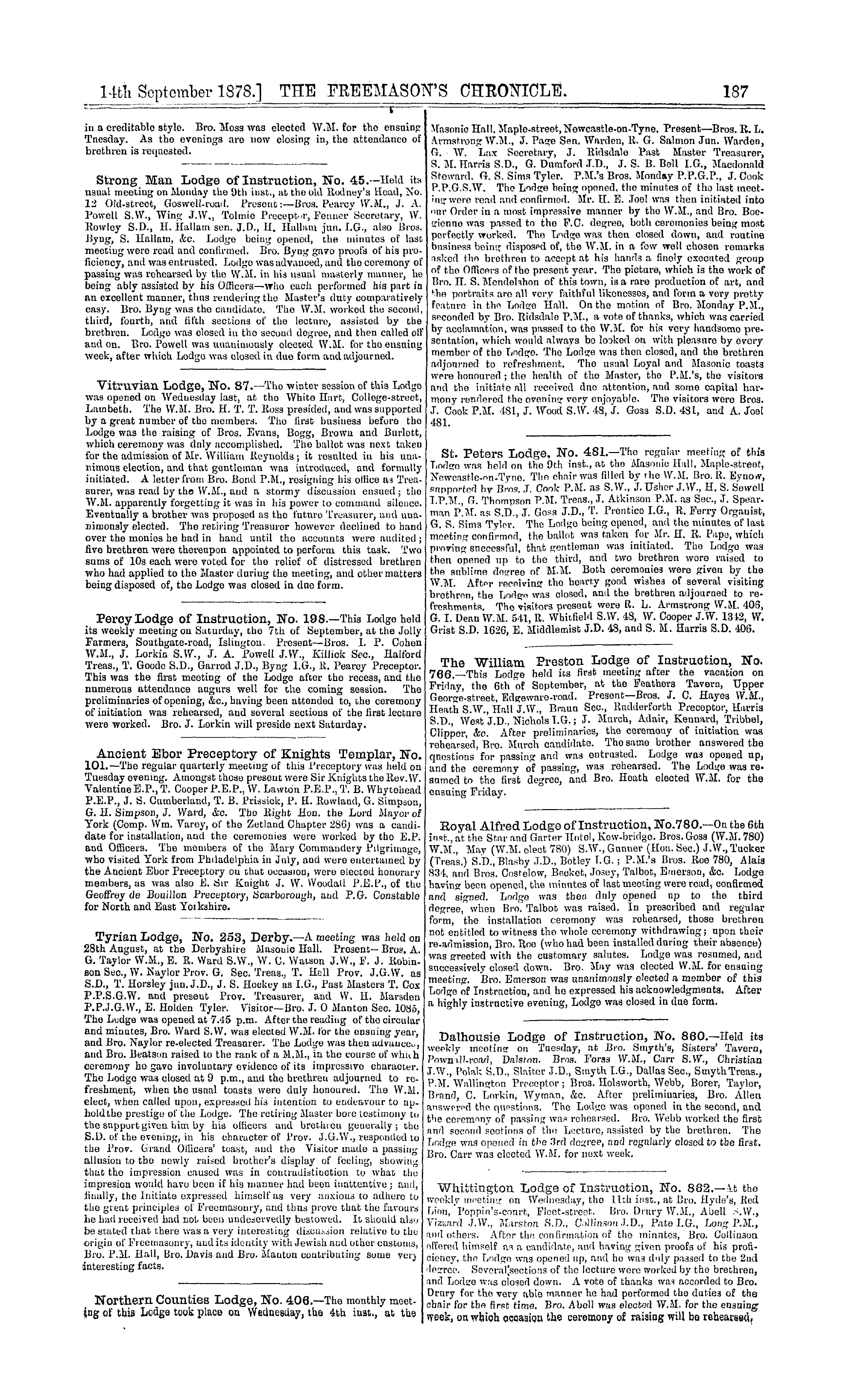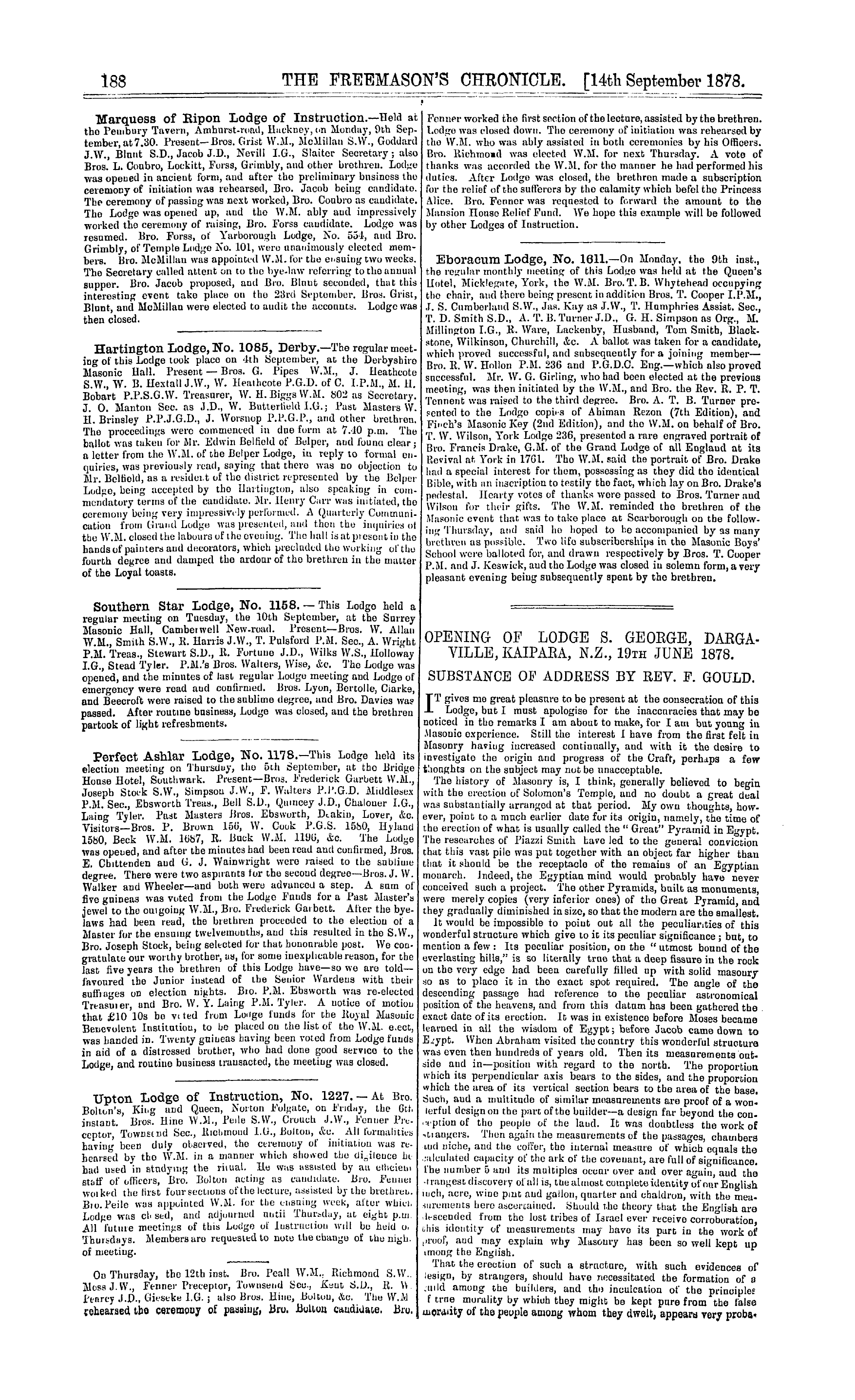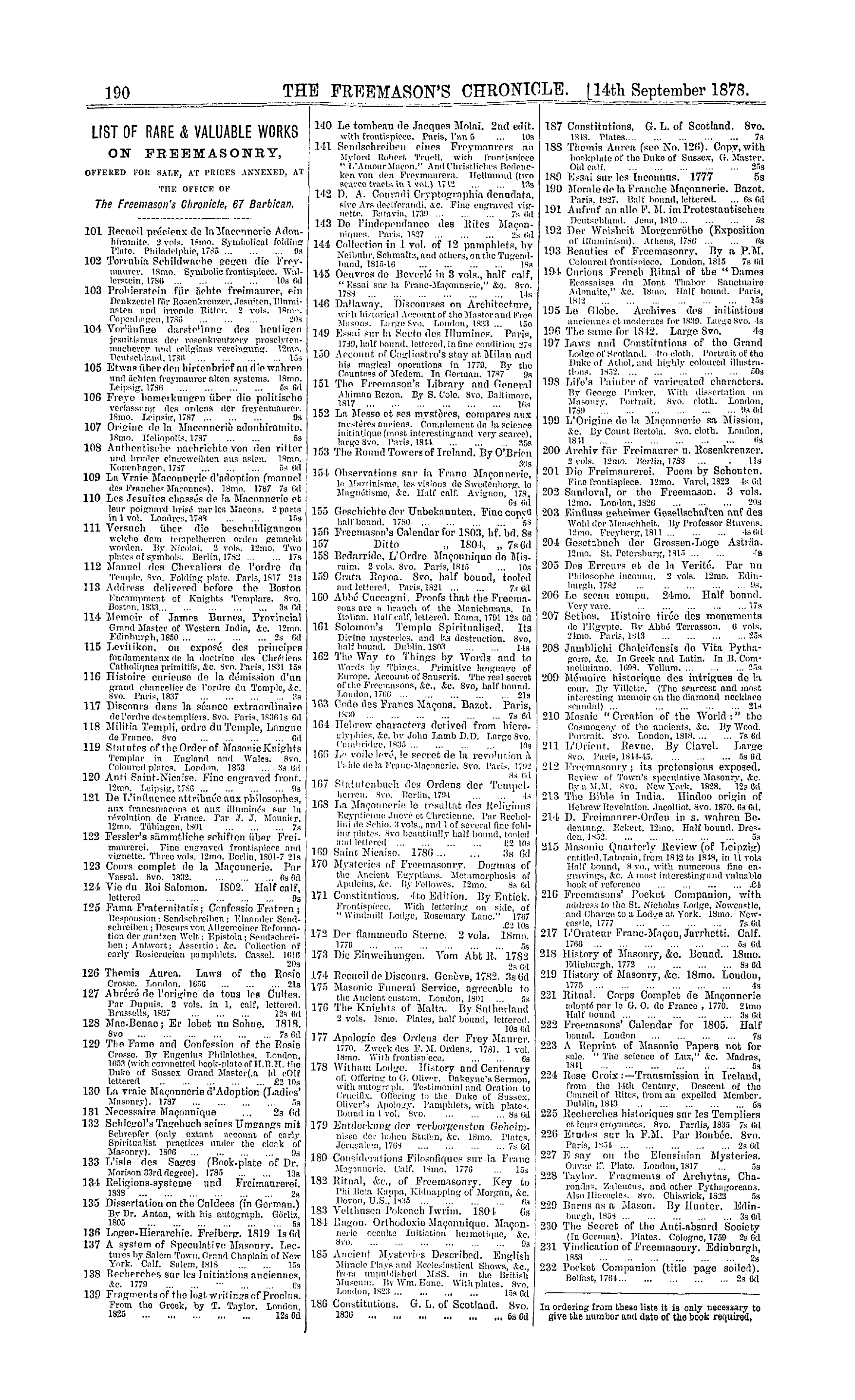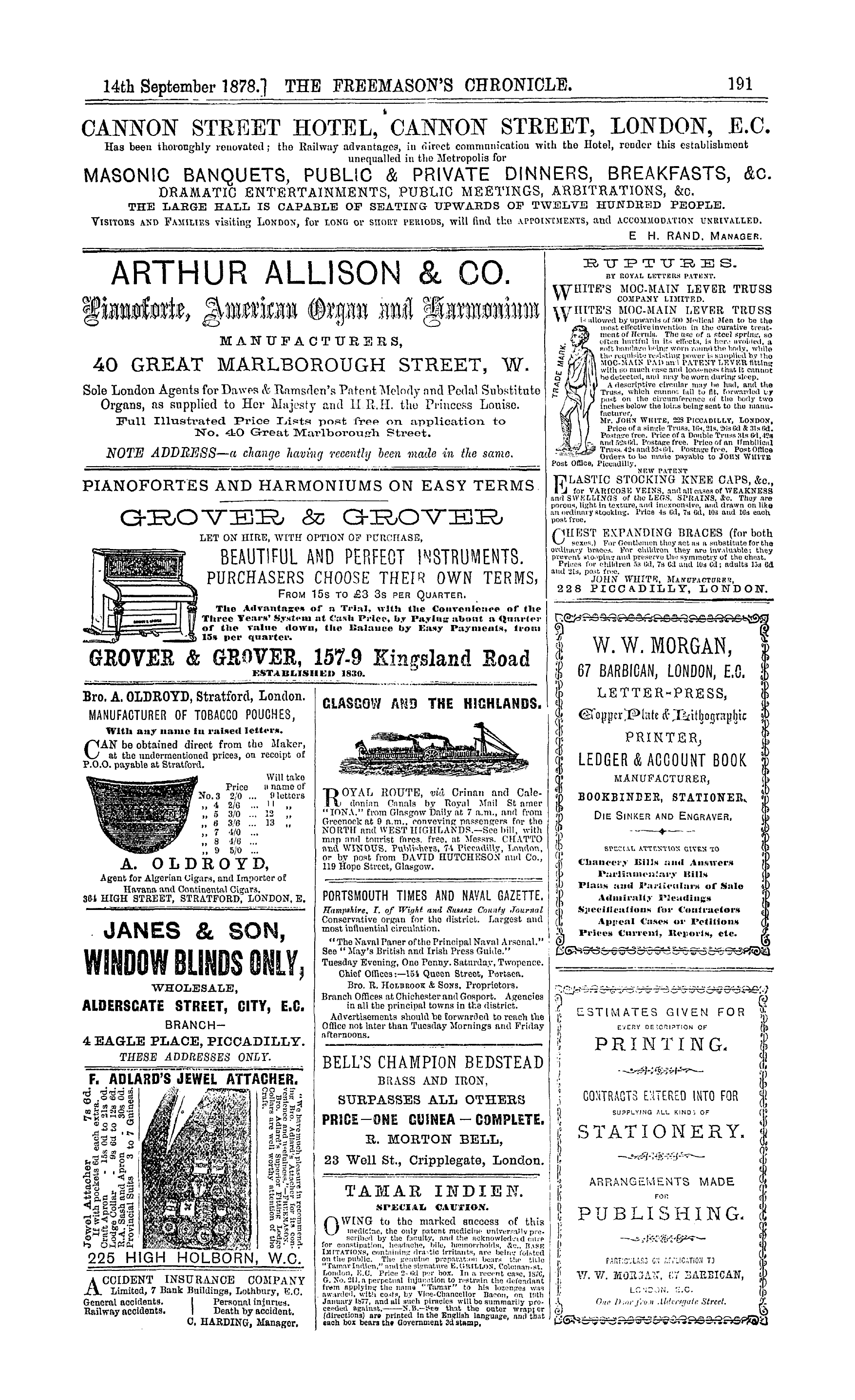-
Articles/Ads
Article THE FOUR OLD LODGES. Page 1 of 2 Article THE FOUR OLD LODGES. Page 1 of 2 →
Note: This text has been automatically extracted via Optical Character Recognition (OCR) software.
The Four Old Lodges.
THE FOUR OLD LODGES .
BRO . R . P . GOULD .
( Continued from page 166 . ) § 28 . —The power of passing and raising Masons , continuously possessed by the old Lodges , may be dismissed
in a few words . Since , by what may be termed a process of " levelling up , " viz ., the extension of this privilege to all Lodges in 1725 , ( ' ) Lodges , old or new , are now on the same footing .
§ . 29 . —Original No . 1 ( Lodge of Antiquity ) would seem , in every way , to have avoided any surrender of its rights , and , indeed , to have powerfully asserted its independency . § 30 . —Original No . 2 , by all authorities alike , is admitted to be defunct .
§ 31 . —I . Original No . 3 ( Fortitude and Old Cumberland ) . The status of this Lodge is open to discussion , ( ) though the point is narrowed to the consideration of a short statement of eight lines only , viz ., the note to
Lodge No . 10 in § 6 , npon which , moreover , Preston entirel y bases Ms estimate of this Lodge ' s position . It is submitted that the brethren of Original No . 3 , from the date of their coming under a new Constitution , suspended
merely , the exercise of their undoubted inherent privileges . It would , indeed , seem to be incompatible with the terms of the compact of 1721 , for them , whilst preserving an unbroken continuity of existence , to surrender rights
inherent in themselves , and confirmed to them in trust for and by the Masons of the Metropolis . ^) These rights would seem to be inalienable ; they were inherent in the members of Original No . 3 , and must have become the
inheritance of succeeding generations , as well as having been the possession of the earliest one . The members are continuous ; there has been no gap between one generation and another , and what was inherent in them must clearly be continuous also .
Grand Lodge having , in the case of Original No . 4 , taken upon itself to revive privileges which it was incapable of creating , out of respect to Past Grand Master Payne ,
might , it is thought , well essay the simpler task of sanctioning the resumption of privileges which are merely dormant , in respect to the memory of Past Grand Master Sayer ?
II . But , as a matter of fact , were these ri ghts surrendered ? This view is only sustainable , on the ground that the acceptance of a warrant , necessarily involved an implied or constructive surrender by Original No . 3 of its
inherent privileges , and if authority and precedent be regarded , no such argument would seem to be maintainable . Under the Grand Lodge of Scotland , it has been inferentially stated ( ' ) that one of , if not both , the two
senior Lodges , Mother Kilwinning and the Lodge of Edinburgh , accepted warrants from the Grand Lodge , and it is matter of history , not only that , believing their ancient
privileges to be assailed , they subsequently retired from the Masonic Union , but also , that so far from their acceptance of warrants being construed into a renunciation of pre-existing privileges , these were increased rather than
diminished on their return " within the fold . " The Master of Mother Kilwinning , in particular ( after the secession of this Lodge from 1743 to 1807 ) , being constituted ipso facto Provincial Grand Master for the Ayrshire district .
III . It has , however , been urged by a very high authority ( Bro . Hughan ) , that Original No . 3 lost its privileges through amalgamation with a junior Lodge ; but with great respect to Bro . Hughan ( whose adverse opinion , I
The Four Old Lodges.
am assured , must militate greatly against the general reception of my conclusions)—( o ) I fail to see any evidence whatever of an amal gamation .
( b ) If such an amalgamation did occur , I am at a loss to understand how this step could possibly involve a loss of precedency in tbe case of the older Lodge , any more than happened on its further absorption of the Old
Cumberland Lodge in the present century . In all amalgamations of this kind , i . e ., unions of two existing Lodges , the doctrine of merger has prevailed , and the lesser precedency has invariably been merged in the higher , as would
naturally occur under the old legal maxim , " Onine majus continet in se mimis , " ( ' ) as illustrated by the rule that " whenever a greater estate and a less , coincide and meet
in one and the same person or body , the less is immediately annihilated ; or , in the law phrase , is said to be merged , that is , sunk or drowned in the greater . ( )
( c ) The earliest amalgamation of Lodges , of which we possess auy authentic record , occurred shortly before the 24 th January 1742 , on which day the Master of No . 95 ( meeting at the Turk ' s Head , Greek-street , Soho ) ,
constituted 12 th December 1732 , surrendered the Warrant of Constitution in Grand Lodge , by reason of its having joined with No . 38 ( meeting at the King ' s Arms , Strand ) , a Lodge which dated from 25 th May 1725 . Q ) On
26 th February 1744-5 , a similar surrender of its Warrant by No . 185 ( Three Tuns , Houghton-street , Clare Market , constituted 4 th November 1740 ) is recorded , on its joining with No . 102 ( Fountain , Katherine-street , Strand , constituted 23 rd May 1733 ) . ( )
( d ) It shonld be added , moreover , that the precedency of Original Nos . 1 and 4 ( present Nos . 2 and 4 ) has been entirely unaffected by their various unions with junior Lodges .
IV . —It appears indeed somewhat anomalous , that whilst the meeting at the Olcl Apple Tree Tavern in 17 ] 7 , is justly regarded as the most momentous event in the
history of the Craft , the old Lodge under whose banner that meeting took place , and who furnished the first Grand Master , who was elected to preside over the Premier Grand Lodge
of the World , has been so totally forgotten , that its ancient privileges have subsided into abeyance , and even its very existence is disputed !!
§ 32 . — -Original No . 4 ( Somerset House and Inverness ) . This Lodge , though spoken of rather disparagingly by Bro . Preston , who , indeed , loses no opportunity of extolling the
Lodge of Antiquity at the expense of the other old Lodges , would seem fully to have retained its Time Immemorial privileges .
Its expulsion from the Masonic Union ( 1747-51 ) , does not necessarily imply , any break in the continuity of its existence as an independent Masonic communit y , since it is most probable that on its restoration to the Union the same members belonged to it who had been such on its
erasure ; although were this not the case it would have been fully " within its rights" during the interim , in discharging the duties of Masonry , by the initiation or admission of members , conformably with its immemorial constitution . ( ° )
§ 33 . —I . No very great antiquity can be claimed for our old English Lodges . It is highly probable that the dates placed opposite the names of original Nos . 1 and 2 in Pine ' s List for 1729 (§ 5 ) express the precise periods of their establishment .
It is certain that ( see § 21 , Note 3 ) , as an official of Grand Lodge ( Note 2 , page 405 ) , Pine would possess unusual facilities of information , besides being placed in a situation of responsibility as regarded accuracy of statement .
Original Nos . 3 and 4 would in this case date between 1712 and 1717 . II . The numbers placed against the old Lodges in the
Note: This text has been automatically extracted via Optical Character Recognition (OCR) software.
The Four Old Lodges.
THE FOUR OLD LODGES .
BRO . R . P . GOULD .
( Continued from page 166 . ) § 28 . —The power of passing and raising Masons , continuously possessed by the old Lodges , may be dismissed
in a few words . Since , by what may be termed a process of " levelling up , " viz ., the extension of this privilege to all Lodges in 1725 , ( ' ) Lodges , old or new , are now on the same footing .
§ . 29 . —Original No . 1 ( Lodge of Antiquity ) would seem , in every way , to have avoided any surrender of its rights , and , indeed , to have powerfully asserted its independency . § 30 . —Original No . 2 , by all authorities alike , is admitted to be defunct .
§ 31 . —I . Original No . 3 ( Fortitude and Old Cumberland ) . The status of this Lodge is open to discussion , ( ) though the point is narrowed to the consideration of a short statement of eight lines only , viz ., the note to
Lodge No . 10 in § 6 , npon which , moreover , Preston entirel y bases Ms estimate of this Lodge ' s position . It is submitted that the brethren of Original No . 3 , from the date of their coming under a new Constitution , suspended
merely , the exercise of their undoubted inherent privileges . It would , indeed , seem to be incompatible with the terms of the compact of 1721 , for them , whilst preserving an unbroken continuity of existence , to surrender rights
inherent in themselves , and confirmed to them in trust for and by the Masons of the Metropolis . ^) These rights would seem to be inalienable ; they were inherent in the members of Original No . 3 , and must have become the
inheritance of succeeding generations , as well as having been the possession of the earliest one . The members are continuous ; there has been no gap between one generation and another , and what was inherent in them must clearly be continuous also .
Grand Lodge having , in the case of Original No . 4 , taken upon itself to revive privileges which it was incapable of creating , out of respect to Past Grand Master Payne ,
might , it is thought , well essay the simpler task of sanctioning the resumption of privileges which are merely dormant , in respect to the memory of Past Grand Master Sayer ?
II . But , as a matter of fact , were these ri ghts surrendered ? This view is only sustainable , on the ground that the acceptance of a warrant , necessarily involved an implied or constructive surrender by Original No . 3 of its
inherent privileges , and if authority and precedent be regarded , no such argument would seem to be maintainable . Under the Grand Lodge of Scotland , it has been inferentially stated ( ' ) that one of , if not both , the two
senior Lodges , Mother Kilwinning and the Lodge of Edinburgh , accepted warrants from the Grand Lodge , and it is matter of history , not only that , believing their ancient
privileges to be assailed , they subsequently retired from the Masonic Union , but also , that so far from their acceptance of warrants being construed into a renunciation of pre-existing privileges , these were increased rather than
diminished on their return " within the fold . " The Master of Mother Kilwinning , in particular ( after the secession of this Lodge from 1743 to 1807 ) , being constituted ipso facto Provincial Grand Master for the Ayrshire district .
III . It has , however , been urged by a very high authority ( Bro . Hughan ) , that Original No . 3 lost its privileges through amalgamation with a junior Lodge ; but with great respect to Bro . Hughan ( whose adverse opinion , I
The Four Old Lodges.
am assured , must militate greatly against the general reception of my conclusions)—( o ) I fail to see any evidence whatever of an amal gamation .
( b ) If such an amalgamation did occur , I am at a loss to understand how this step could possibly involve a loss of precedency in tbe case of the older Lodge , any more than happened on its further absorption of the Old
Cumberland Lodge in the present century . In all amalgamations of this kind , i . e ., unions of two existing Lodges , the doctrine of merger has prevailed , and the lesser precedency has invariably been merged in the higher , as would
naturally occur under the old legal maxim , " Onine majus continet in se mimis , " ( ' ) as illustrated by the rule that " whenever a greater estate and a less , coincide and meet
in one and the same person or body , the less is immediately annihilated ; or , in the law phrase , is said to be merged , that is , sunk or drowned in the greater . ( )
( c ) The earliest amalgamation of Lodges , of which we possess auy authentic record , occurred shortly before the 24 th January 1742 , on which day the Master of No . 95 ( meeting at the Turk ' s Head , Greek-street , Soho ) ,
constituted 12 th December 1732 , surrendered the Warrant of Constitution in Grand Lodge , by reason of its having joined with No . 38 ( meeting at the King ' s Arms , Strand ) , a Lodge which dated from 25 th May 1725 . Q ) On
26 th February 1744-5 , a similar surrender of its Warrant by No . 185 ( Three Tuns , Houghton-street , Clare Market , constituted 4 th November 1740 ) is recorded , on its joining with No . 102 ( Fountain , Katherine-street , Strand , constituted 23 rd May 1733 ) . ( )
( d ) It shonld be added , moreover , that the precedency of Original Nos . 1 and 4 ( present Nos . 2 and 4 ) has been entirely unaffected by their various unions with junior Lodges .
IV . —It appears indeed somewhat anomalous , that whilst the meeting at the Olcl Apple Tree Tavern in 17 ] 7 , is justly regarded as the most momentous event in the
history of the Craft , the old Lodge under whose banner that meeting took place , and who furnished the first Grand Master , who was elected to preside over the Premier Grand Lodge
of the World , has been so totally forgotten , that its ancient privileges have subsided into abeyance , and even its very existence is disputed !!
§ 32 . — -Original No . 4 ( Somerset House and Inverness ) . This Lodge , though spoken of rather disparagingly by Bro . Preston , who , indeed , loses no opportunity of extolling the
Lodge of Antiquity at the expense of the other old Lodges , would seem fully to have retained its Time Immemorial privileges .
Its expulsion from the Masonic Union ( 1747-51 ) , does not necessarily imply , any break in the continuity of its existence as an independent Masonic communit y , since it is most probable that on its restoration to the Union the same members belonged to it who had been such on its
erasure ; although were this not the case it would have been fully " within its rights" during the interim , in discharging the duties of Masonry , by the initiation or admission of members , conformably with its immemorial constitution . ( ° )
§ 33 . —I . No very great antiquity can be claimed for our old English Lodges . It is highly probable that the dates placed opposite the names of original Nos . 1 and 2 in Pine ' s List for 1729 (§ 5 ) express the precise periods of their establishment .
It is certain that ( see § 21 , Note 3 ) , as an official of Grand Lodge ( Note 2 , page 405 ) , Pine would possess unusual facilities of information , besides being placed in a situation of responsibility as regarded accuracy of statement .
Original Nos . 3 and 4 would in this case date between 1712 and 1717 . II . The numbers placed against the old Lodges in the
